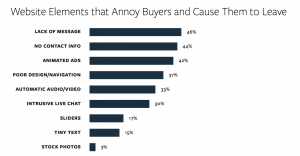
Are you tempted to skip steps in content marketing?
Admit it: sometimes you’re tempted to skip a key step in your content marketing.
It’s easy to understand why. Content marketing is hard, hard work that encompasses many demanding and varied tasks, leading to a proliferation of urgent deadlines.
That’s why takes a talented, smoothly functioning team to get your content marketing done well.
Unfortunately, when you get super-busy with urgent projects, it’s tempting to skip part of the content marketing work.
The problem is, when you skip a key step, it hurts your content marketing results. Just like skipping steps can hurt your garden.
Let’s start at the beginning, for content marketing and gardening:
Having no content marketing strategy is like not clearing the ground for your garden. Unless you start with a clean sheet of paper (or a cleared garden plot), you can never get as far.
Way too many content marketers skip the crucial first step of writing down the content marketing strategy. While marketers may have the best intentions to get back around to it, the editorial calendar sets so many deadlines there’s not time to think through strategy, only time to produce content.
In fact, the 2015 Content Marketing Institute (CMI) studies showed that 65% of B2B marketers and 73% of B2C marketers lack a written strategy.
You can get ahead of most marketers: here’s a free template for your content marketing strategy.
As Joe Pulizzi of CMI observes, following your written strategy increases your odds of success by 8 times.
Nothing else you can do will make your content marketing 8 times more powerful. So clear the ground: start with strategy.
Having no message is like having no good seeds to plant in your garden.
Everything to come grows out of your message. It’s the seed you want to spread. Make sure you have the best possible message that tells your audience: what’s in it for them?
Way too many marketers don’t have a message. In fact, 41% of B2B websites lack a message.

When people don’t get the message, it’s the number one reason they leave B2B websites.
Avoid being abandoned at the first opportunity because you lack a message. Co-create your company’s 1-page Message Map.
Having no buyer personas is like planting in unknown soils. Know your soil and you’ll know what will grow best there.
For example, if there’s moss on the ground in your yard, it’s too acidic for grass – yet it’s perfect for azaleas. You can either treat the soil to make it less acidic and grow grass – or plant an azalea. Either way, your garden will flourish because you know the soil and what will grow best there.
Similarly, knowing your customers’ buying habits can get you into their buying cycles. Which ideas are your customers most responsive to, and when?
To get those insights you need buyer personas, based on deep research with real customers. Insights into how buyers find information, what steps they take in making a purchase, where they run into obstacles, and who are involved in the buying decision are simply invaluable to marketing.
Without buyer personas, you will find that some things work and others don’t – but you won’t necessarily understand the reasons why. Knowing your customers, like knowing your soil, makes the rest of the job much easier.
Not having an editorial calendar is like not knowing when to plant. A good editorial calendar starts with awareness of when your customers budget, buy and use your products and services. So you can deliver exactly the right content at the right time.
That’s just like knowing when each plant will grow in your garden. For example, in Chicago, you can plant cool weather crops like lettuce and spinach early in April. If you wait until June your cool weather crops will wither in the heat.
Now that it’s September, many companies are planning their budgets for next year. They’re starting to think about what to buy. Getting the right content in front of your audience at the right time, when they start to think about buying, gives you an advantage.
Not auditing your content is like not knowing whether your garden gets sun or shade. You need to know which content thrives in your market by doing a content audit – a complete inventory of what’s working and what’s not working.
In your garden, shade-loving plants wilt in the sun and sun-loving plants won’t grow in the shade. Similarly, your content works in some places and not in others.
With a content audit, you learn what’s working best and where more of the right content could thrive.
Perhaps you’ll want to look beyond your own content. Take a peek over the fence to see what competitors are doing with their content – and how it’s going.
With a competitive content audit, you can find the best content ideas and invent new ways to make them uniquely your own.
Not reviewing analytics regularly is like not checking your plants for disease or pests. Review analytics quarterly or monthly, to see how your content is performing, to stop bad things from getting worse and to multiply your successes.
With big data analytics in hand, you can form hypotheses about why certain content is working and other content isn’t working. That means you can plant more of what works and weed out what doesn’t.
Making regular adjustments based on your analytics is the way to maximize your results in content marketing – and in your garden.
Not linking content marketing to demand generation is like not harvesting. You’ve done all the work to grow a beautiful crop of prospects. Now it’s time to harvest new customers and sales.
Don’t leave your crop in the fields to feed scavengers. You’ve put in a lot of work to get this far. Make sure your company reaps the rewards.
Use lead scoring to identify the customers who are likeliest to buy. Especially early on, the quality of leads counts far more than quantity.
Give your sales force only the best of your best marketing-qualified leads to improve their odds of closing sales. A few closed sales will make them hungry for even more high-quality, marketing-qualified leads.
As a content marketer and gardener, I offer these thoughts on the seasons in content marketing and gardening:
7 Lessons for Content Marketers from Gardeners in Summer
7 Lessons for Content Marketers from Gardeners in Winter
5 Lessons for Content Marketers from Gardeners in Spring
By the way, this week I’m in Cleveland at Content Marketing World, live-Tweeting @riverwordguy. Next week I’ll share with you some lessons from the world’s leading content marketers at #CMW15.
Contact Us
Related Posts
Top 100 Content Marketing Question: How do you promote content / preferred method?
To promote content, distribute it 3 ways: 1. Owned media Put most of your work into creating great content you can own such as...
Content Marketing: Magnify the Problem, Spur Buyers to Act
The weakest link in BtoB marketing happens on the first step in the buyers’ journey. In step 1, buyers try to figure out whether...
Discover a tool that makes 24 communications jobs easier to do
Discover a tool that makes 24 communication jobs easier to do Does your company have one crystal-clear, consistent, and compelling strategic message? Every company...
What do you want to be known for?
Here’s a hard question marketers need to ask: What’s the one thing your brand wants to be known for? People will remember only one...





